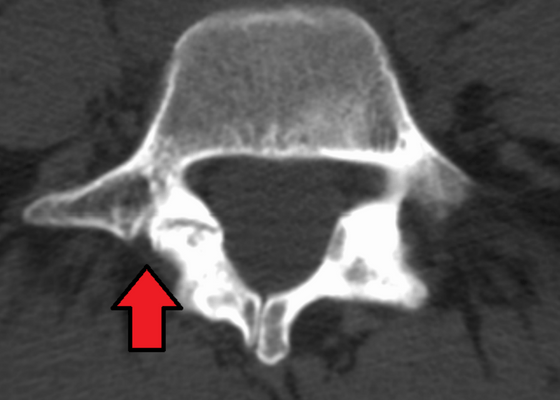Listhesis, also called spondylolisthesis or anterolisthesis, is the displacement of a vertebra. In essence, spondylolisthesis is when one vertebra slips on top of the vertebra positioned below. Depending on how this displacement or slippage took place, there are several types of spondylolisthesis. In this article, we will present the main types of the condition as well as their pathological aspects.

Classification of Spondylolisthesis
The medical literature has found it appropriate to classify spondylolisthesis according to its location, cause, and severity. Depending on these factors, your physicians can recommend non-invasive treatments, such as chiropractic or more radical approaches such as spinal surgery.
More information on listhesis is available for patients who wish to explore additional means of treatment or interest in post-surgical rates of recovery when chiropractic is employed.
Depending on the factors mentioned above, there are several types of spondylolisthesis.
A) Spondylolisthesis by cause
There are six major types of listhesis depending on what causes the condition:
1. Dysplastic
Also called type 1, this form of spondylolisthesis has been observed in 14 to 21 percent of cases. From an anatomical standpoint, dysplastic spondylolisthesis is caused by a congenital defect, and it’s virtually undetectable by ultrasonography or other forms of medical imaging like CT. Clinical observations noted that dysplastic spondylolisthesis stems from an anomaly detected in the interior of the upper sacral facet of L5 (the fifth lumbar vertebra).
2. Isthmic
Known also as type 2, this form of listhesis is caused by an anomaly detected in the pars interarticularis (a part of the vertebra located at the intersection of the superior and the inferior articular processes of the joint).
3. Degenerative
Called type 3, degenerative listhesis has frequently been observed in individuals over 50, women, and patients of African-American descent. It is usually caused by arthritis (joint and facet arthritis). As noted in the field, the displacement of the vertebra occurs when the ligamentum flava (connectors between vertebrae and laminae) is weakened by an underlying condition.
4. Traumatic
Type 4 spondylolisthesis is very rare, and, naturally, not so well-document as the others. Traumatic spondylolisthesis is caused by blunt trauma to the spinal column, followed by a fracture of the neural arch.
5. Pathologic
Also called type 5 in accordance with the method of classification, pathologic spondylolisthesis is caused either by antibiotic-resistant infection or by specific forms of cancer that affect the spinal cord.
6. Post-Surgical
Called type 6 or iatrogenic, this form is caused by certain complications that could appear after the surgery. In severe cases, your doctor might up for follow-up surgery to relieve some of the symptoms, such as a compressed spinal cord.

B) Spondylolisthesis by location
As we’ve pointed out, there are several means of classifying spondylolisthesis. The second method employed by diagnosticians is its location. As an overview, the condition has been observed in young patients, typically between the ages of 6 and 16 years.
Curiously enough, even though spondylolisthesis occurs at such a fragile age, it sinks below the radar, only to resurface during late adulthood.
From a statistical standpoint, the most common form of spondylolisthesis is isthmic, affecting roughly 5 to 7 percent of US patients.
This method of classification is used to point out which vertebrae are affected, and, most importantly, which parts of the vertebrae have been damaged.
According to this method, there are three types of spondylolisthesis:
1. Pars Fatigue Fracture
Trauma or a congenital defect can lead to a pars interarticularis fracture.
2. Pars Elongation
This type of spondylolisthesis usually occurs after the healed pars have been subjected to additional stress or trauma.
3. Pars Acute Fracture
As a result of extreme trauma, the pars can present multiple cracks on its surface. This usually calls for emergency surgery.
C) Spondylolisthesis by severity
This category refers to how severe the displacement is. Measured in degrees or percentage and in relation to the vertebral body, this category incorporates five subtypes.
- Grade I with a displacement between 0 and 25 percent.
- Grade II with slippage between 25 and 50 percent.
- Grade III, which means that the vertebra is displaced by 50 to 75 percent from the vertebral body.
- Grade IV, with a displacement between 75 and 100 percent.
- Grade V with a displacement equal or greater than 100 percent.
Conclusion
The purpose of this taxonomic approach is to allow your physician to decide on the best course of treatment. Do keep in mind that some forms of spondylolisthesis can be treated using non-invasive procedures such as physical therapy or chiropractic. However, depending on the location, severity, and cause, your doctor might recommend surgery to avoid further complications.
 Kaboutjie SA Mommy Blogs by Lynne Huysamen
Kaboutjie SA Mommy Blogs by Lynne Huysamen




